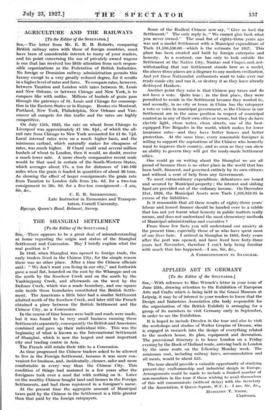AGRICULTURE ' AND • THE RAILWAYS
[To the Editor of the SPECTATOR.] SIR,—The letter from Mr. E. R. B. Roberts, comparing British railway rates with those of foreign countries, must baye been of considerable interest to many of your readers, and his point concerning the use of privately owned wagons is one that has received too little attention from such respon- sible organizations as the Federation of British Industries. No foreign or Dominion railway administration permits this luxury except to a very greatly reduced degree, for it results in a higher level of rates and fares. To compare rates, however, between Taunton and London with rates between St. Louis and New Orleans, or between Chicago and New York, is to compare like with unlike. Millions of bushels of grain pass through the gateways of St. Louis and Chicago for consump- tion in the Eastern States or in Europe. Routes via Montreal, Portland, New York, Philadelphia, New Orleans and Van- couver all compete for this traffic and the rates are highly competitive.
On July 15th, 1923, the rate on wheat from Chicago to Liverpool was approximately .11 10s. 91d., of which the all- rail rate from Chicago to New York accounted for £1 Os. 71d. Local internal rates were on a much higher basis, and the minimum carload, which naturally makes for cheapness of rates, was much higher. If Chard could send several million bushels of wheat to London, then it would, no doubt, receive a much lower rate. A more closely comparative recent scale would be that used in certain of the South-Western States, which averages about 17s. a ton for distances of 140400 miles when the grain is loaded in quantities of about 30 tons. As showing the effect of larger consignments the grain rate frOm Taunton to London falls from 24s. 6d. for a two-ton consignment to 20s. 9d. for a five-ton consignment.—I am, Sir, &c., C. E. R. SHERRINGTON, Late Instructor in Economics and Transpor- tation, Cornell University.
Byways, Queen's Road, Belmont, Surrey.






















































 Previous page
Previous page